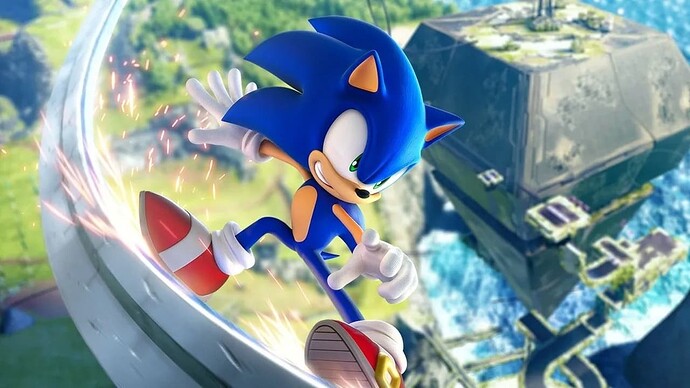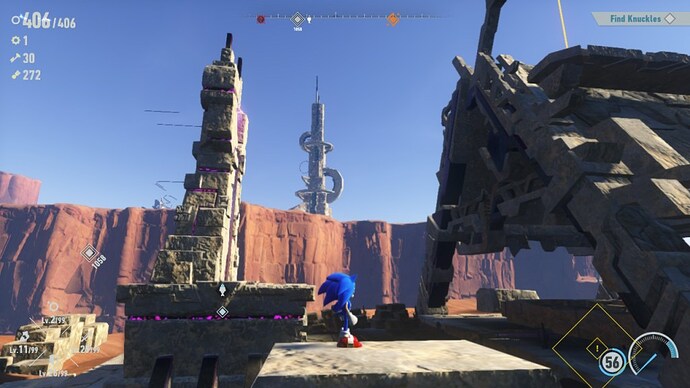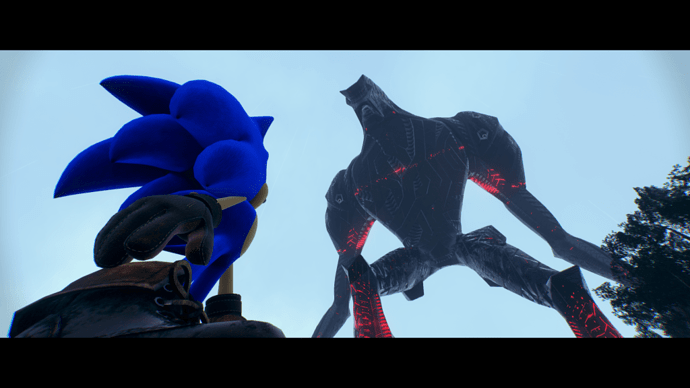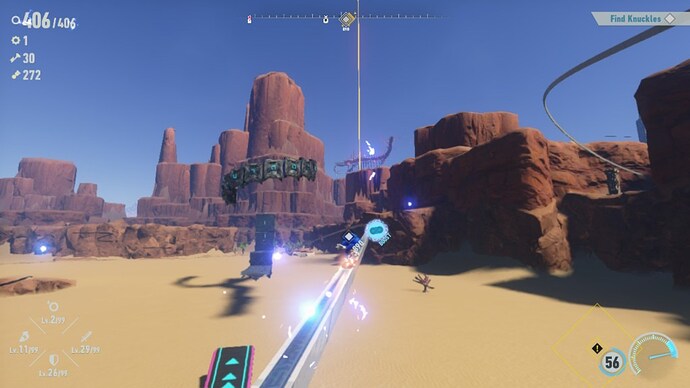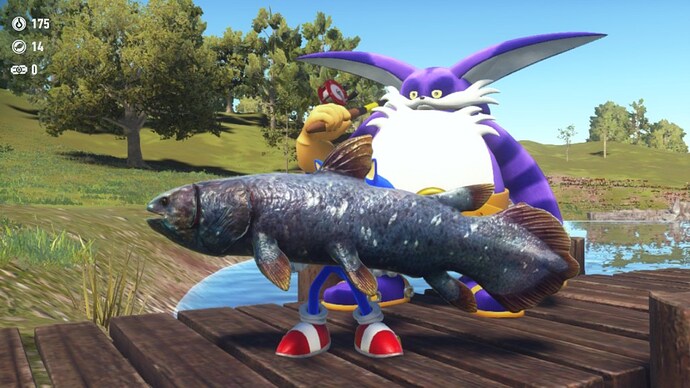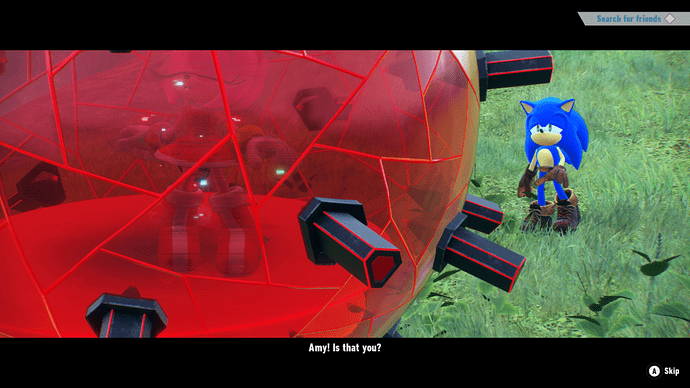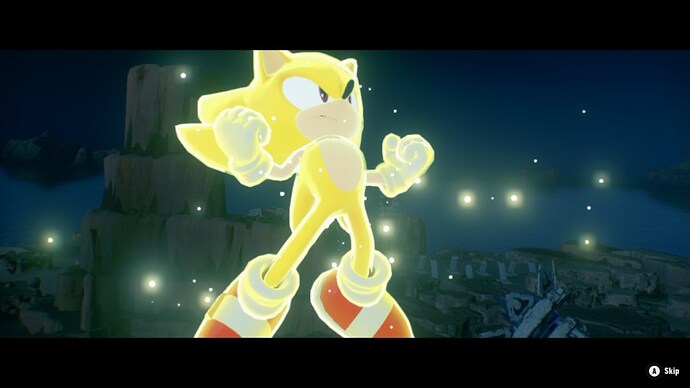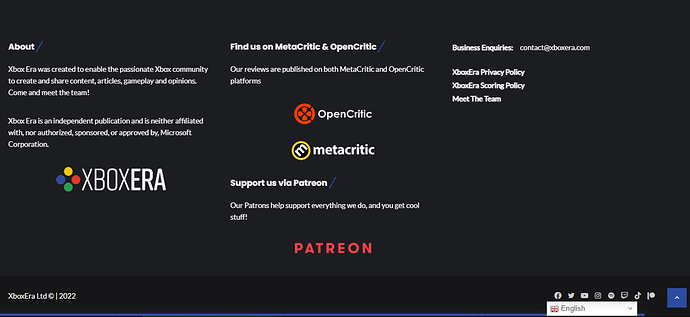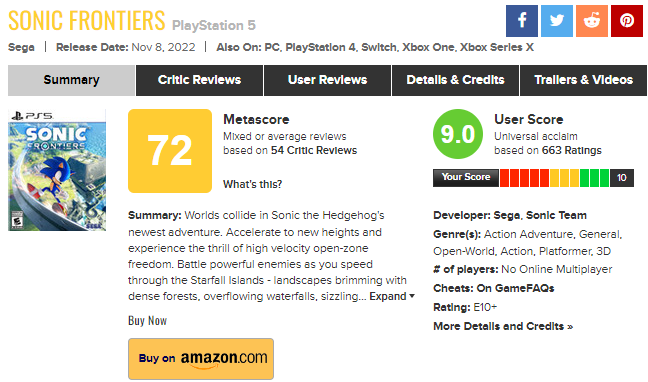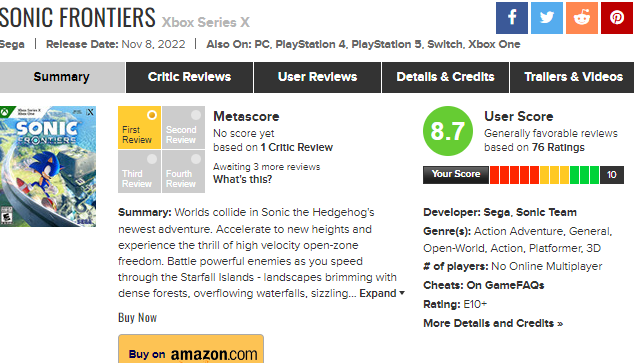Originally published at: Review | Sonic Frontiers - XboxEra
The year is 2022 and we’re talking about a new Sonic release. It wasn’t that long ago that we’d get one, sometimes even two, game releases of everyone’s favourite blue hedgehog. But now he’s like the rest of the industry where, understandably, game development can take well over four years to complete. And in Sonic’s case (COVID complications included), it’s been five years since the release of the rather middling Sonic Forces. Due credit should be given to Sonic Team—they always try something new with Sonic and I can appreciate that. This time, Sonic goes open world, a radical change from his usual linear stage-based gameplay and it’s a change that I think should be iterated on despite Sonic Frontiers’ significant flaws.
But let’s cut to the chase: Sonic Frontiers is an action-adventure game developed by Sonic Team and published by SEGA. Trapped on the ‘Starfall Islands’ after a rough crash-landing, Sonic will need to rescue his friends and escape the islands while in the process of uncovering the mystery of what came before.
Sonic is the Fighters
For the uninitiated, Sonic is all about speed. Be it on a 2D or 3D plane, he lives to go fast, weaving his way through stage obstacles, assists, and hazards. Now it all takes place outside the confines of the limited worlds of Unleashed, Heroes, Lost World, and etcetera—all of Frontiers’ five Starfall Islands can be fully traversed and it’s truly refreshing. Objectives placed across the maps typically have multiple paths that you can take to reach them. Some of that will involve rail grinding or rings that launch Sonic far into the distance. And once you have a knack for the controls, you can more or less force your way through hard to climb mountains without breaking a sweat and make Todd Howard proud. Clearing each map will take roughly four to five hours each, with plenty of mini challenges the player will need to clear in order to fill in the details on the map linked to the View button.
Across these large swaths of land, you will find plenty of enemies to fight and collectibles to pick up. Enemies can range from small fry to mini bosses that will drop gears needed to active the ‘cyber levels’ within each island. Said cyber levels are essentially tiny portions of old stages from previous games that, when completed, will yield ‘vault keys’ that are required to unlock a subset of the Chaos Emeralds that are locked away. The other Chaos Emeralds are found by conversing with one of Sonic’s friends that are bound to that particular map—but not after collecting the required number of ‘memory tokens’ needed to stabilize them.
Once all the Chaos Emeralds have been retrieved, Sonic can advance to the final boss of the map and take them on as everyone’s favourite transformation Super Sonic form. These fights are more spectacle than challenge, but I liked them quite a lot.
One of the best things Frontiers has done for this series is implementing a functional and fun combat system. Previous Sonic games have been marred by poor combat systems—Sonic Heroes, Black Knight, Unleashed, the whole lot of ’em—and I’m happy to say that Sonic Team has finally found the best possible sweet spot for our blue hero. Sonic’s primary attack is done by pressing X repeatedly but building up combo is necessary to pull off other skills that you’ll be able to unlock via the skill tree. Performing enough hits triggers a phantom rush that will do plenty of damage to your opponent. Mind you, this isn’t a deep fighting system by any means, but it works well in the confines of the enemies and their mechanics. It’s not slow or clunky and many of the attacks are accompanied by lots of flash and cool sound effects. These skills also stretch into the Super Sonic form which feels great to use.
The enemies from cyberspace are varied in designs and mechanics. Some are simply doorknobs used to dart from platform to platform while others will require either parrying or dodging out of the way of big attacks. Sonic’s latest ability, cycloning, lets him encircle enemies and environmental triggers alike and is very useful for the former when you don’t really know how to take on a new foe. If you find yourself barely doing damage to enemies or losing too many rings, you can always trade in a set of collectibles to the lanky Elder Koco who will upgrade your defense and offence.
Speaking of which, there is also another shorter and wider Elder Koco who will take on one of your collectable items called ‘Kocos’ who are scattered all over the islands. He’s in the business of giving Sonic either a larger ring pouch or increasing his speed skill, which is incredibly important and unfortunately part of what makes this game a very frustrating Sonic experience for me.
Rolling at the Speed of Limits
For the significantly improved combat experience, Sonic Frontiers trades in just about everything I like about Sonic games: going fast and going fast in well-designed levels that encourage replays for better times and scores. Nearly all of your 20-hour playtime of this game will be spent in the open world maps and, despite the nice change of pace they offer from previous games, these maps aren’t exactly great to traverse. Running in a straight line is impossible because you’ll find yourself stuck in a rail-grind section that could easily send you in the opposite direction of where you were going. You can’t easily escape these sections either because they force the 2D camera perspective and that takes away your other axes of escape.
But I need to address the elephant in the room: Sonic doesn’t go fast. Holding the right trigger to boost is basically a requirement because Sonic’s normal speed never gets him anywhere and the boost is weak even after the upgrades. If it’s not apparent enough out in the open world, simply load into one of the cyber levels and watch how some fantastic levels of old have become shadows of themselves, stripped of all things that made them interesting and instead leaving a husk for Sonic to (slowly) run his way through empty tiles of land and rails. To add insult to injury, seagulls will sometimes fly alongside the blue blur while he’s boost running.
Sonic has also become this weightless monstrosity. In previous games, Sonic ‘heft’ let him have momentum of sorts, even in the later games that introduced the boost mechanic to hit top speed. This helped ground Sonic to the world and meant that you’d need to learn the game’s physics in order to best manipulate your position and, in turn, get Sonic to stay at top speed all the time. In Frontiers, all that is gone and that leaves Sonic feeling like someone’s first Roblox obby game. You’ll notice this as you run around the world and watch as our blue friend randomly flies into the air if he even hits a tiny bump (and there’s plenty of those). And for the cherry on top, certain trips or assist tiles will stop your boost, forcing you to constantly press the right trigger again to keep moving.
I understand that moving Sonic to an open world is a challenge, but some of these feels more like Sonic Team doesn’t trust the player and will do their darndest to keep you from playing Frontiers the way you want to. And you can see this when taking on just about any challenge: there will always be a giant text box telling you what you need to do to complete it. Be it a boss fight or a map puzzle, this game handholds you to the nth degree all the way up to the final boss fight. I fully believe in making games accessible but Sonic Frontiers takes the laziest possible route to do so—why make puzzles when you’re just going to give the answers?
Bad cyber levels and Sonic mechanics aside, I’d like to stress to the reader that the game is perfectly playable. Sonic isn’t broken like he was in ’06, but he’s pretty boring to play as. And that goes for the gameplay loop as once you’ve experienced the first two hours of the game, it doesn’t change beyond that. You’ll see some new foes and map puzzles to clear but by and large you’ll mostly be playing to collect and advance the game’s story. It does get monotonous but if you get tired of all that, you can fish with everyone’s favourite giant purple fuzzball: Big the Cat.
The fishing minigame needs to be found on each island but once you’ve spotted it, you can jump in and borrow Big’s fishing rod. Don’t expect much from this mode—you can quite literally play the whole thing with one button press. It doesn’t matter where you toss the hook, you’ll catch a bite really quickly and amass a bunch of fishing tokens within minutes. As lame as this minigame is, the tokens you collect can be traded in for the very collectibles you could spend hours running around the map for (ergo, clearing out the padding faster). You can also trade in tokens for Eggman memos where he mumbles on about his thoughts on cyberspace and events from previous games. I liked these memos and I’m a sucker for any reference to old Sonic games, even if it’s just lip service, but I do find it odd that you can only find these memos in this minigame and not out in the open world where plenty of Eggtech is lying about.
In the end I found myself more frustrated with the execution of the open world and how Sonic was implemented into that game design philosophy that just about every IP has been toying with for the last several years. But for what it’s worth, I did find fun in running about and unlocking more of the map over time. There’s a lot of verticality too, and I enjoyed those moments where I could catch a random collectible without having to take on the challenge for it. There is pleasure to be had in the little bits of freedom Sonic Team gives the player.
The random assortment of Sonic level mechanics just floating around do look weird. The pop-in can get distracting too. But it does make sense within the context of the story, so I let it pass. And besides, the game looks pretty good especially at 60 frames per second on the Series X (apologies in advance for Switch owners). Chaos Island is a real looker, especially during daylight. There’s not much in the way of animations however—poor Sonic will only shake his head once in a while for his idle and that’s just a sad sight to see.
One final thought goes to the user interface. It’s modern and doesn’t get in the way and I like it for that. But it’s slightly cumbersome to use and you’ll notice this as you try to get access to the options, skill tree, and Elder Koco menus. But the biggest sin is the lack of a minimap. During gameplay, the bottom left of the screen shows the current level of all of Sonic’s stats: attack, defense, speed, and ring power. You will rarely look at this part of the screen because it’s useless information that could’ve been shoved into the skill tree menu somewhere and a minimap would have been better suited here (particularly because it’s an open world game). Having to constantly load up the map to look for a collectible gets annoying, and this function also commits the sin of cutting out Ohtani Tomoya and companies’ awesome music for the duration that it’s open.
It’s the little things, but they do add up to larger grievances.
Melancholic Adventures
Everything you do in Sonic Frontiers is to advance to the next cutscene. Too simple a judgement but it’s true: the game has a lot of cutscenes, telling the story of the Starfall Islands and what came before. Sonic games have been trying to be more serious about their stories since Forces and Frontiers continues to carry that torch—the game touches on subjects like death and loss, finding your true self, and familial ties. These themes can be felt throughout the islands and even character inflections. The cast isn’t their chipper selves in this game, opting for a more serious tone but personally speaking it left me feeling a bit detached, hearing the likes of Amy Rose or Eggman speak in room voices rather than their cheery and hearty language. But credit where credit is due, the game nails its tone.
Sonic goes up against Sage, a little girl borne of Eggman’s programming and her integration into Cyberspace. She questions him aplenty, asking why he keeps going when the odds are against him, and Sonic always answers in his own way: he knows he can win. I liked the interactions between these two and I felt that this bond was built a lot better over the course of the game than other story beats that rear their heads in such as Tails feeling useless or Eggman growing closer to Sage. Heck, there’s a supposed ’emotional’ cutscene with Sage halfway through the game that ends up feeling poorly presented and kind of laughable. This is thanks to a lack of screen time for many of these characters—not even the ‘memory token’ interactions (with animations on par with the original Deus Ex) cover these pacing issues proper. Ultimately, I found that some story beats led to unsatisfying conclusions.
To add to all this, although I did like the references to previous games, they do feel shoehorned in as to create some sort of continuity to future games. Like I said, it’s lip service so while it may delight some for a brief moment to hear Eggman talk about Maria, these ideas never go anywhere (and in Eggman’s case, it would have helped me understand his train of thought in this game).
Perhaps the most exciting moment of any Sonic game release, however, is the original soundtrack. Ohtani Tomoya, Eguchi Takahito, and the other composers who worked on this game have nailed everything that needed to accompany this game’s gameplay and story. From the tired, defeated themes of Kronos Island to the sandy dunes of Ares Island, the overworld music progresses over the course of each Chaos Emerald collected. This increases the breadth of instrumentation present in the islands’ themes alongside a shift in pitch and tone—they’re really pleasant to listen to. Cyber levels and boss fights range from remixes of music from previous games with a trap slash EDM cover to early-to-mid 2000s alternative rock with vocals and I really enjoyed these pieces. Seriously wicked to hear the likes of Tyler Smyth from Dangerkids show up again as he did great work on Infinite’s theme way back.
There is also a single from ONE OK ROCK titled “Vandalize” that plays during the end credits, but I didn’t really care for it. The lyrics didn’t match the themes of the game and it felt like it was one verse too short. At least the instrumentals were cool.
We Can Build From Here
Sonic Frontiers takes on the open world genre with not much grace. There’s a lot of stumbling around and that’s likely due to a lack of budget, but this is also a great starting point for Sonic. I think large scale maps like this can work with our blue hedgehog, but it needs a lot more than haphazardly tossing stages and their mechanics out and about. Sonic Team also needs to know that it’s okay to let the player sink or swim—the whole point of going ‘open world’ is giving players freedom and when you try to railroad them by giving them the answers and keys to all the game’s challenges at the door, there’s not much left for the player to uncover on their own.
Ultimately, Sonic Frontiers struggles with creating interesting levels and challenges in its large maps filled to the brim with padding. But if you can look past that, there is fun to be had within its frustrating confines.
| Reviewed On | Xbox Series X, Nintendo Switch |
| Available On | Xbox One, Xbox Series, PlayStation 4, PlayStation 5, Nintendo Switch, PC/Steam |
| Release Date | 8th of November, 2022 |
| Developer | SEGA/Sonic Team |
| Publisher | SEGA |
| ESRB / PEGI Ratings | E10+ for Everyone 10 and Up – Fantasy Violence / PEGI 7 – Fear, Violence |
